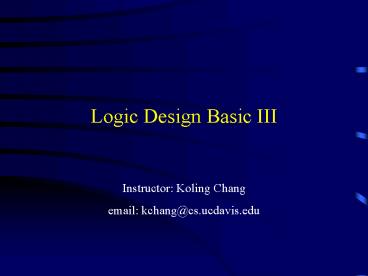Logic Design Basic III - PowerPoint PPT Presentation
1 / 17
Title:
Logic Design Basic III
Description:
Series-parallel implementation. 2-gate delay. Koling Chang - ECS154A - Fall 2003. Page 10 ... BC . AC. Koling Chang - ECS154A - Fall 2003. Page 12 ... – PowerPoint PPT presentation
Number of Views:29
Avg rating:3.0/5.0
Title: Logic Design Basic III
1
Logic Design Basic III
- Instructor Koling Chang
- email kchang_at_cs.ucdavis.edu
2
Outline
- Logic function simplification (cont.)
- Quine-McCluskey Method
- Generalized Gates
- Using Other Gates
3
Quine-McCluskey Method
- Simplification involves two steps
- Obtain a simplified expression
- Essentially uses the following rule
- X Y X Y X
- This expression need not be minimal
- Next step eliminates any redundant terms
- Eliminate redundant terms from the simplified
expression in the last step - This step is needed even in the Karnaugh map
method
4
Quine-McCluskey Method (cont.)
- Steps to find prime implicants
- group minterms with same number of 1s.
- eliminate terms using the Simplification Law
- XYXY X
- between neighboring groups and generate new
neighboring groups. - repeat until this law can not be applied.
5
Quine-McCluskey Method (cont.)
- Example
- f(a,b,c,e) S (0,1,2,5,6,7,8,9,10,14)
- Column I Column II Column III
- group 0 0 0000 0,1 000- 0,1,8,9 -00-
- group 1 1 0001 0,2 00-0 0,2,8,10 -0-0
- 2 0010 0,8 -000 0,8,1,9 -0-0 X
- 8 1000 1,5 0-01 0,8,2,10 -0-0 X
- group 2 5 0101 1,9 -001 2,6,10,14 --10
- 6 0110 2,6 0-10 2,10,6,14 --10 X
- 9 1001 2,10 -010
- 10 1010 8,9 100-
- group 3 7 0111 8,10 10-0
- 14 1110 5,7 01-1
- 6,7 011-
- 6,14 -110
- 10,14 1-10
6
Quine-McCluskey Method (cont.)
- f acd abd abcbc bd cd
- Can you simplify this function using consensus
theorem? - XYYZXZ XYXZ
- b(ad)(ad)cbc badbc
- d(ab)(ab)cdc dabdc
- cbbdcd cbcd
- f abdbccd
7
Quine-McCluskey Method (cont.)
- Prime Implicant Chart
- 0 1 2 5 6 7 8 9 10 14
- (0,1,8,9) bc X X X X
- (0,2,8,10) bd X X X X
- (2,6,10,14) cd X X X X
- (1,5) acd X X
- (5,7) abd X X
- (6,7) abc X X
8
Generalized Gates
- Multiple input gates can be built using smaller
gates - Some gates like AND are easy to build
- Other gates like NAND are more involved
9
Generalized Gates (cont.)
- Various ways to build higher-input gates
- Series
- Series-parallel
- Propagation delay depends on the implementation
- Series implementation
- 3-gate delay
- Series-parallel implementation
- 2-gate delay
10
Multiple Outputs
- Two-output function
- A B C F1 F2
- 0 0 0 0 0
- 0 0 1 1 0
- 0 1 0 1 0
- 0 1 1 0 1
- 1 0 0 1 0
- 1 0 1 0 1
- 1 1 0 0 1
- 1 1 1 1 1
- F1 and F2 are familiar functions
- F1 Even-parity function
- F2 Majority function
- Another interpretation
- Full adder
- F1 Sum
- F2 Carry
11
Implementation Using Other Gates
- Using NAND gates
- Get an equivalent expression
- A B C D A B C D
- Using de Morgans law
- A B C D A B . C D
- Can be generalized
- Majority function
- A B B C AC A B . BC . AC
12
Implementation Using Other Gates (cont.)
- Majority function
13
Implementation Using Other Gates (cont.)
- Bubble notation for even-parity function
14
Implementation Using Other Gates (cont.)
- Using XOR gates
- More complicated
- A XOR B AB AB
- Even-parity example
- ABC ABC ABC ABC
- C(ABAB) C (AB AB)
- C(ABAB) C (ABAB)
- C(ABAB) C (ABAB)
15
Proof of Last Two Lines
- (abab)
- (ab) (ab)
- (a b ) (ab)
- aa ab ba bb 0 ab ba 0
- ab ba
16
Implementation Using Other Gates (cont.)
- Using XOR gates
- More complicated
17
Proof of F2
- F2 BC AB AC
- BC AB(CC) AC(BB)
- BC ABC ABC ABC ABC
- BC A( BC BC)































